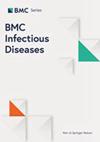加纳医护人员自我报告的血液和体液接触情况以及终生接触乙型肝炎病毒的血清学证据:一项横断面研究
IF 3
3区 医学
Q2 INFECTIOUS DISEASES
引用次数: 0
摘要
仅在撒哈拉以南非洲地区,医护人员中约有 40-65% 的乙型肝炎病毒感染是由于经皮职业暴露于患者受污染的血液和体液所致。在加纳,医护人员的血液和体液职业暴露呈上升趋势。然而,自我报告暴露于疑似受乙型肝炎病毒污染的血液和体液与实际血清学证据之间的关系仍然未知。本研究的目的是评估加纳医护人员自我报告的乙型肝炎病毒暴露情况与终生暴露于乙型肝炎病毒的血清学证据及相关因素之间的关系。该研究是一项横断面分析调查,采用简单随机抽样程序从大阿克拉地区五个区的六名工作人员中招募了 340 名医护人员。参与者使用有效的工具进行调查,并无菌抽取 5 毫升静脉血用于抗-HBc 的定性检测。使用 SPSS 23.0 版对数据进行分析,得出比例、几率比例及其相应的置信区间,显著性水平设定为 0.05。回复率为 94%,其中护士和医生占大多数,平均年龄为 35.6 ± 7.2 岁。自报感染 HBV 的比例为 63%,而终生感染 HBV(抗 HBc)的比例为 8.2% (95% CI = 5.0-11.0%)。女性感染 HBV 的几率比男性低 60%(aOR = 0.4;95% CI = 0.1-0.9)。没有接受过预防血液传播感染培训的医务工作者一生中接触 HBV 的几率几乎是男性的三倍(aOR = 2.6;95% CI = 1.0-6.4)。这项研究的结果表明,自我报告的接触 HBV 污染生物材料的几率很高,因此终生接触 HBV 的几率也相应较高。女性是抗 HBc 感染的保护因素。除了采取直接干预措施防止在医疗环境中职业暴露于 HBV 外,定期对各类医疗工作者进行感染预防技术培训可显著减少暴露于乙型肝炎病毒的机会。本文章由计算机程序翻译,如有差异,请以英文原文为准。
Self-reported exposure to blood and body fluids and serological evidence of lifetime exposure to hepatitis B virus among health care workers in Ghana: a cross-sectional study
In Sub-Saharan Africa alone, about 40–65% of Hepatitis B Virus infections among HCWs were a result of percutaneous occupational exposures to contaminated blood and body fluids of patients. Occupational exposure to blood and body fluids among healthcare workers is on the rise in Ghana. However, the relationship between self-reported exposures to blood and body fluids suspected to be contaminated with the hepatitis B virus and actual serological evidence of exposure remains unknown. The aim of the study however was to assess the self-reported exposure to HBV as against the serological evidence of lifetime exposure to HBV and associated factors among Ghanaian HCWs. The study was a cross-sectional analytical survey that involved 340 HCWs who were recruited using a simple random sampling procedure from six cadres of staff from five districts in Greater Accra. The participants were surveyed using a validated instrument and 5mls of venous blood was aseptically withdrawn for qualitative detection of Anti-HBc. SPSS version 23.0 was used to analyze the data to obtain proportions, odds ratios and their corresponding confidence intervals with the level of significance set at 0.05. The response rate was 94% with Nurses and Doctors in the majority with a mean age of 35.6 ± 7.2. Self-reported exposure to HBV was 63% whereas lifetime exposure to HBV (Anti-HBc) prevalence was 8.2% (95% CI = 5.0-11.0%). Females were 60% less likely to be exposed to HBV (aOR = 0.4; 95% CI = 0.1–0.9) than their male counterparts. HCWs without training in the prevention of blood-borne infections had almost three times higher odds of being exposed to HBV in their lifetime (aOR = 2.6; 95% CI = 1.0-6.4). The findings of this study suggest that self-reported exposure to HBV-contaminated biological materials was high with a corresponding high lifetime exposure to HBV. The female gender was protective of anti-HBc acquisition. Apart from direct interventions for preventing occupational exposures to HBV in the healthcare setting, periodic training of all categories of healthcare workers in infection prevention techniques could significantly reduce exposure to the Hepatitis B virus.
求助全文
通过发布文献求助,成功后即可免费获取论文全文。
去求助
来源期刊

BMC Infectious Diseases
医学-传染病学
CiteScore
6.50
自引率
0.00%
发文量
860
审稿时长
3.3 months
期刊介绍:
BMC Infectious Diseases is an open access, peer-reviewed journal that considers articles on all aspects of the prevention, diagnosis and management of infectious and sexually transmitted diseases in humans, as well as related molecular genetics, pathophysiology, and epidemiology.
 求助内容:
求助内容: 应助结果提醒方式:
应助结果提醒方式:


